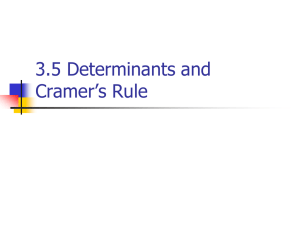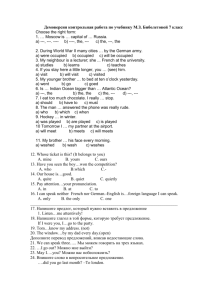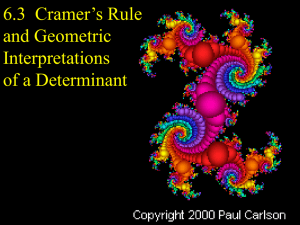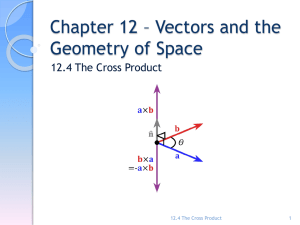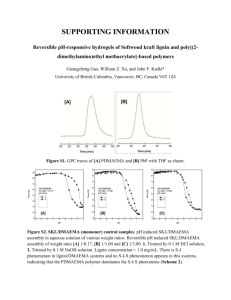H in 2nd quantization
advertisement
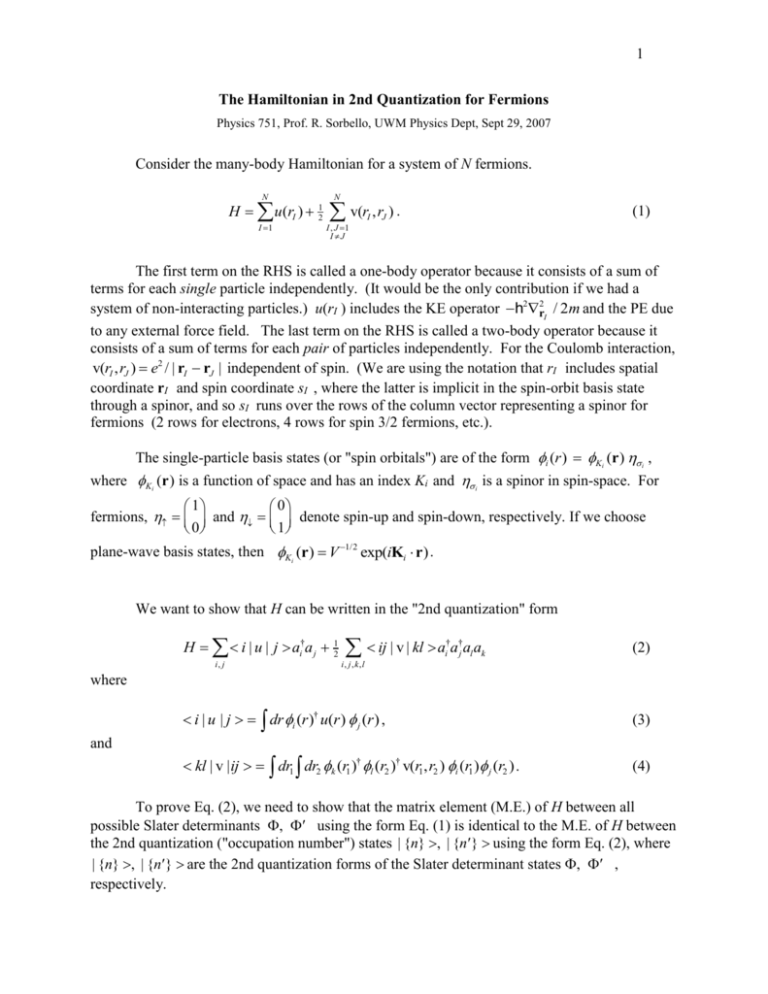
1
The Hamiltonian in 2nd Quantization for Fermions
Physics 751, Prof. R. Sorbello, UWM Physics Dept, Sept 29, 2007
Consider the many-body Hamiltonian for a system of N fermions.
N
H u(rI )
I 1
N
1
2
v(r ,r ) .
I
(1)
J
I , J 1
IJ
The first term on the RHS is called a one-body operator because it consists of a sum of
terms for each single particle independently. (It would be the only contribution if we had a
system of non-interacting particles.) u(rI ) includes the KE operator h2r2I / 2m and the PE due
to any external force field. The last term on the RHS is called a two-body operator because it
consists of a sum of terms for each pair of particles independently. For the Coulomb interaction,
v(rI ,rJ ) e2 / | rI rJ | independent of spin. (We are using the notation that rI includes spatial
coordinate rI and spin coordinate sI , where the latter is implicit in the spin-orbit basis state
through a spinor, and so sI runs over the rows of the column vector representing a spinor for
fermions (2 rows for electrons, 4 rows for spin 3/2 fermions, etc.).
The single-particle basis states (or "spin orbitals") are of the form i (r) Ki (r) i ,
where Ki (r) is a function of space and has an index Ki and i is a spinor in spin-space. For
1
0
fermions, and denote spin-up and spin-down, respectively. If we choose
0
1
plane-wave basis states, then Ki (r) V 1/2 exp(iKi r) .
We want to show that H can be written in the "2nd quantization" form
H i | u | j ai†a j 12
i, j
ij | v | kl a a a a
† †
i j l k
(2)
i, j,k,l
where
i | u | j dr i (r)† u(r) j (r) ,
(3)
kl | v |ij dr1 dr2 k (r1 )† l (r2 )† v(r1,r2 ) i (r1 ) j (r2 ) .
(4)
and
To prove Eq. (2), we need to show that the matrix element (M.E.) of H between all
possible Slater determinants using the form Eq. (1) is identical to the M.E. of H between
the 2nd quantization ("occupation number") states | {n} , | {n} using the form Eq. (2), where
| {n} , | {n} are the 2nd quantization forms of the Slater determinant states ,
respectively.
2
Now, we need to keep track of the basis states occupied in the Slater determinants and all
the basis states as displayed in | {n} | n1 , n2 ... n . By definition, the basis state labels 1, 2…
in the many-body state | n1 , n2 ... n refer to space and spin quantum numbers K11 , K22,…
K , placed in increasing order. We adopt the convention that the set of occupied states in the
Slater determinant is denoted by the subscripts E1 , E2 ... E N , where the ordering of these labels
is from smallest value to largest value, in the same sense as the ordering of the basis states n j in
the list n1 , n2 ... n in the many-particle state | {n} | n1 , n2 ... n . Thus, E1 E2 ... EN refer to
a specific sub-set of N of the infinite possible particle labels 1, 2… . Similarly, we denote the
occupied states in by the subscripts E1, E2 ... E N , where E1 E2 ... EN . We can write the
Slater determinants for and in the permutation-notation or in the explicit determinantal
notation as follows:
E (r1 ) E (r2 ) ... E (rN )
E (r1 ) E (r2 ) ... E (rN )
1
1
(1)P E1 (r1 ) E2 (r2 )... EN (rN )
N! P
1
N!
1
2
1
2
2
E (r1 ) E (r2 ) ... E (rN )
N
N
E (r1 ) E (r2 ) ... E (rN )
E (r1 ) E (r2 ) ... E (rN )
1
1
1
(1)P E (r1 ) E (r2 )... E (rN )
1
2
N
N! P
N!
N
1
2
1
2
2
E (r1 ) E (r2 ) ... E (rN )
N
N
N
N
(5)
One-body operators
We first process the 1-body operator in Eq. (1), and consider the term for a specific
particle coordinate, say I=1. The result for <| u(r1) |> will be the same as for <| u(r2)
|> or <| u(r3) |>, etc., since the particle label doesn't matter for a system of identical
particles. Therefore,
N
| u(rI ) | N | u(r1 ) | .
(6)
I 1
To find <| u(r1) |>, we go after all the r1-dependent terms in Eq. (5) by expanding
the determinants in minors (using the first column since that is where r1 appears). This gives
3
1
%E (1) E (r1 )
%E ... (1)N 1 E (r1 )
%E ]
[ E1 (r1 )
1
2
2
N
N
N!
1
%E (1) E (r1 )
%E ... (1)N 1 E (r1 )
%E ]
[ E1 (r1 )
1
2
2
N
N
N!
(7)
%E (r2 ,r3 ,...rN ) is the determinant of the remaining (N–1) basis states in after
where E j
j
% (r ,r ,...r ) is the determinant of the remaining (N–1) basis
excluding E . Similarly,
E j
j
E j
2
3
N
states in after excluding E j .
From Eq. (7), we get
| u(r1 ) |
1
% †
% dr dr ...dr .
(1)i 1 (1) j 1 dr1 Ei (r1 )† u(r1 )E j (r1 )
Ei
Ej
2 3
N
N! E E
i
(8)
j
where we used the fact that there are j–1 states occupied before state j in E j and there are i –1
states occupied before state i in Ei
% dr dr ...dr gives zero unless all
By orthonormality of basis states, the integral Ei†
Ej
2 3
N
states in Ei and E j match, meaning that all states other than Ei in must match all states
other than Ej in and in that case we have the normalization integral for an (N–1)( N–1)
determinant, which equals (N–1)!. This gives
| u(r1 ) |
1
(1)i 1 (1) j 1 dr1 Ei (r1 )† u(r1 ) E j (r1 ).
N E E
i
(9)
j
For the complete matrix element | u(rI ) | for the N-body system, we get N
I
times the result of Eq. (9), in agreement with Eq. (6), and finally giving
N
| u(rI ) |
I 1
(1)
i 1
(1) j 1 Ei | u | E j
(10)
Ei E j
We now need to show that the RHS of Eq. (10) is equal to the matrix element for the onebody Hamiltonian in the 2nd quantized form as it appears in Eq. (2), namely,
4
n1, n2 ... n | i | u | j ai†a j | n1,n2 ...n
i, j
(11)
Note that the ai†a j factor ensures that there is no contribution unless j is occupied in
| n1 , n2 ...n and i is occupied in | n1, n2 ... n . All other single-particle states not equal to j or i
must have the same occupation numbers in | n1, n2 ... n and | n1 , n2 ...n because of the
orthogonality of | n1 , n2 ...n and | n1, n2 ... n for different occupation numbers. The ai†a j
operators also give the phase factor (1)i (1) j , where i and j are the number of occupied
states before state i in | n1, n2 ... n and before the state j in | n1 , n2 ...n , respectively. But this
phase factor is exactly the value of the phase factor (1)i 1 (1) j 1 appearing in Eq. (10). Thus,
Eqs. (10) and (11) agree, proving that the 2nd quantized form given in the first term of Eq. (2) is
correct for 1-body operators.
Two-body operators
N
To find the M.E. for
v(r ,r ) , we go after v(r1, r2).
I
J
The result for this matrix element
I , J 1
IJ
will be the same as for all other v(rI , rJ), so can just multiply the M.E. for v(r1, r2) by the factor
N
N(N–1) to get the M.E. for
v(r ,r ) .
I
J
We proceed by factoring-out the particle coordinates r1
I , J 1
IJ
and r2 from states and of Eq. (5). So instead of Eq. (7), which factored-out only the
coordinate r1, we write
1
S %
Ei (r1 ) E j (r2 ) (1) ij
Ei E j
N ! Ei E j
(12)
1
%
Ek (r1 ) El (r2 ) (1)Skl
Ek El
N ! Ek El
where the phase factors required to extract the two basis states as shown from the original Slater
determinants (by expansion in minors) are written as (–1) raised to the powers Sij and Skl for
and , respectively. The wavefunctions Ei E j and Ek El are (N–2)(N–2) determinants
containing all basis states originally in and , respectively, except for states appearing as
subscripts in Ei E j and Ek El .
5
The M.E. becomes
| v(r1 ,r2 ) |
1
S
% †
% dr ...dr .
(1)Skl (1) ij dr1 dr2 Ei (r1 ) †E j (r2 )† v(r1,r2 )Ek (r1 )El (r2 )
EiE j
Ek El
3
N
N! E E E E
i
j
k
l
(13)
The orthogonality of the basis states gives a factor of (N-2)! for the integral over dr3…drN
and requires all the basis states in and to match except for the states Ei, E j in
and Ek , El in . This gives
| v(r1,r2 ) |
1
S
(1)Skl (1) ij EiE j | v | Ek El ,
N(N 1) EiE j Ek El
(14)
and finally
| 12
N
v(r ,r ) |
I
J
I , J 1
IJ
1
2
S
(1)Skl (1) ij EiE j | v | Ek El .
(15)
Ei E j Ek El
Now consider the matrix element for the 2-body Hamiltonian in the 2nd quantized form
as it appears in Eq. (2):
n1, n2 ... n | 12
ij | v | kl a a a a
† †
i j l k
| n1,n2 ...n .
(16)
i, j,k,l
The ai†a†j al ak factor ensures that there are only contributions when k and l are occupied in
| n1 , n2 ...n and i and j are occupied in | n1, n2 ... n and that the occupation numbers for all
single-particle states except for i,j,k,l are the same in | n1 , n2 ...n and | n1, n2 ... n . Thus,
Eqs. (15) and (16) agree in all respects provided that the phase factor introduced by ai†a†j al ak is
the same as that appearing in Eq. (15). It is left as an exercise to show that the phase factors are
the same, thus proving that the 2nd quantized form of the Hamiltonian is correctly given by Eq.
(2). (This can be done by working out the various possibilities exhaustively, i.e., for i<j , k<l,
for i<j , k>l, for i>j , k<l, and for i>j , k>l.)
Added comment: There is an important restriction on the states appearing in the
evaluation of the M.E. that is required for the M.E. to be non-zero, although the restriction did
not have an explicit role in the previous derivations. The restriction for the case of the 1-body
Hamiltonian in the 2nd quantization form given by Eq. (11) is this: The state j must appear in
| n1 , n2 ...n and must be absent in | n1, n2 ... n ; the state i must appear in | n1, n2 ... n and
must be absent in | n1 , n2 ...n ; all other states (excluding i and j) are the same in
| n1 , n2 ...n and | n1, n2 ... n . This follows from the fact that
a†j ai acting on
| n1 , n2 ...n destroys the state i and creates the state j, which means that the final state
6
| n1, n2 ... n is just like | n1 , n2 ...n except that it has an extra particle in j and is missing a
particle in i. The same restriction is also implicit in the Slater determinant form Eq. (8), since the
integral over dr2…drN requires all the basis states in and to match except for the states Ei
in and E j in . This is possible only if the state Ei does not appear in and the state E j
does not appear in .
Similarly, for the 2-body Hamiltonian: In the form shown in Eq. (16), the states l and k
must appear in | n1 , n2 ...n and must be absent in | n1, n2 ... n , and similarly the states i and j
must appear in | n1, n2 ... n and must be absent in | n1 , n2 ...n , but all other states (excluding i,
j, k and l) are the same in | n1 , n2 ...n and | n1, n2 ... n . This follows from the fact that
ai†a†j al ak acting on | n1 , n2 ...n only changes the occupied states l and k to the occupied states i
and j, leaving all states other than i, j, k, l as they were originally. This is also implicit in the
Slater determinant form Eq. (13), since the integral over dr3…drN requires all the basis states in
and to match except for the states Ei, E j in and Ek , El in . This is possible only if the
states Ei, E j do not appear in and the states Ek , El do not appear in .
